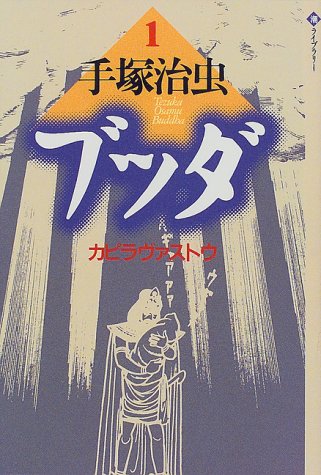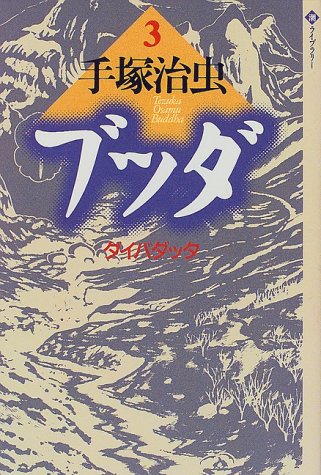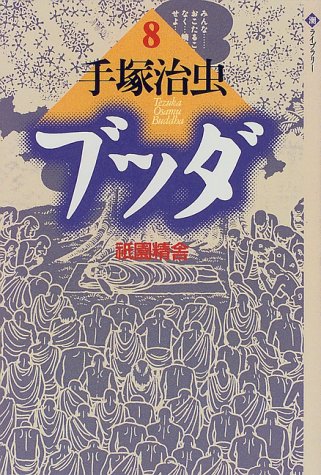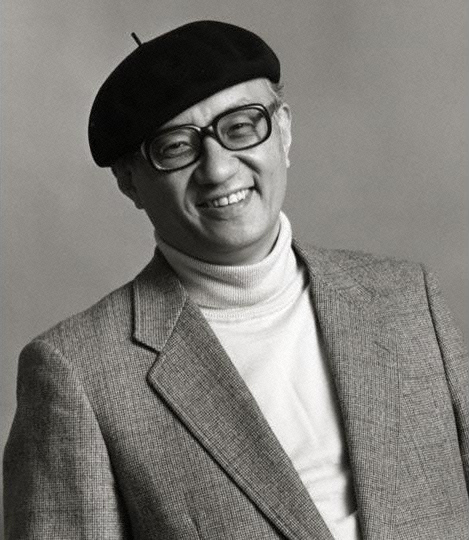


Books in series

#1
Buddha, Vol. 1
Kapilavastu
1972
Osamu Tezuka's vaunted storytelling genius, consummate skill at visual expression, and warm humanity blossom fully in his eight\-volume epic of Siddhartha's life and times. Tezuka evidences his profound grasp of the subject by contextualizing the Buddha's ideas; the emphasis is on movement, action, emotion, and conflict as the prince Siddhartha runs away from home, travels across India, and questions Hindu practices such as ascetic self\-mutilation and caste oppression. Rather than recommend resignation and impassivity, Tezuka's Buddha predicates enlightenment upon recognizing the interconnectedness of life, having compassion for the suffering, and ordering one's life sensibly. Philosophical segments are threaded into interpersonal situations with ground\-breaking visual dynamism by an artist who makes sure never to lose his readers' attention.
Tezuka himself was a humanist rather than a Buddhist, and his magnum opus is not an attempt at propaganda. Hermann Hesse's novel or Bertolucci's film is comparable in this regard; in fact, Tezuka's approach is slightly irreverent in that it incorporates something that Western commentators often eschew, namely, humor.

#1
ブッダ (1)
1987

#2
Buddha, Vol. 2
The Four Encounters
1983
Osamu Tezuka’s vaunted storytelling genius, consummate skill at visual expression, and warm humanity blossom fully in his eight\-volume epic of Siddhartha’s life and times. Tezuka evidences his profound grasp of the subject by contextualizing the Buddha’s ideas; the emphasis is on movement, action, emotion, and conflict as the prince Siddhartha runs away from home, travels across India, and questions Hindu practices such as ascetic self\-mutilation and caste oppression. Rather than recommend resignation and impassivity, Tezuka’s Buddha predicates enlightenment upon recognizing the interconnectedness of life, having compassion for the suffering, and ordering one’s life sensibly. Philosophical segments are threaded into interpersonal situations with ground\-breaking visual dynamism by an artist who makes sure never to lose his readers’ attention.
Tezuka himself was a humanist rather than a Buddhist, and his magnum opus is not an attempt at propaganda. Hermann Hesse’s novel or Bertolucci’s film is comparable in this regard; in fact, Tezuka’s approach is slightly irreverent in that it incorporates something that Western commentators often eschew, namely, humor.

#3
Buddha, Vol. 3
Devadatta
1983
The Eisner and Harvey WinnerThe third volume of this epic graphic novel send Siddhartha further into a world mired in pain and suffering. The journey to peace and enlightenment looms far but bright.Prince Siddhartha quickly learns that the monk's path is covered in thorns and self\-abuses much more profound than shaving your head. His new companions Dhepa and Assaji accompany him to plague\-ridden town, ruled by the ravashing Visakha. On a different path filled with as many vararies is Devadatta, an orphan who learns only that bad almost always gets worse.To strange cities, and dire prophecies...

#3
ブッダ (3)
2025

#4
Buddha, Vol. 4
The Forest of Uruvela
1983
The Eisner and Harvey WinnerIn this fourth volume of the award\-winning graphic novel biography, Buddha slowly discovers that his destiny lies in a path not readily available to him. With fellow ascetics Dhepa who has complete faith in the purifying quality of painful physical ordeals, and Assaji, who can predict everyone's death to the hour, Buddha travels through the kingdom of Magadha into the Forest of Uruvela, where The Middle Path and Enlightenment wait beyond a series of death\-defying trials.Awake under the Pippala tree...
![ブッダ 4 [Buddha 4] book cover](https://images-na.ssl-images-amazon.com/images/S/compressed.photo.goodreads.com/books/1681498675i/119986554.jpg)
#4
ブッダ 4 [Buddha 4]
1987
王族の娘ヤショダラ姫を妃に迎えた後も、シッダルタの胸には愛しいミゲーラへの想いが消えない……。王宮での虚飾の生活に疲れたシッダルタは、ついに出家の道を歩むことを決意するのだが……。大河ドラマ第4弾!

#5
Buddha, Vol. 5
Deer Park
1983
In the fifth installment of manga\-godfather Osamu Tezuka's Buddha, engagement with death imparts the lesson of life's sancity. In a Machiavellian rise to power, Devadatta, a rogue aristrocrat, incites war between two kingdoms that will leave thousands dead. King Bimisara of Magadha, fearing death his son's own hand, withdraws fatherly love. The true measure of the Buddha's divinity will turn out to be a test of diplomacy \- the power of words.

#6
Buddha, Vol. 6
Ananda
1983
In the sixth volume of manga visionary Osamu Tezuka's Buddha, the devil Mara possesses the bandit Ananda, half\-brother of Devadatta, in an effort to eliminate the Buddha. A ruthless killer who is impervious to physical harm, Ananda will retain the devil's favor only if he spurns his love interest.
When Ananda and his bandit buddy attack the Fire Shrine of the Brahmin brothers Kassapa, it is none other than the Awakened One who happens by. Buddha must confront his eternal enemy, Mara, before he can open the eyes of arrogant priests and hardened criminals.
#6
ブッダ 6 [Buddha 6]
2025
多くの弟子を抱えることになったブッダの元には、自然と人々が集まりはじめた。しかし、彼はまだ数多くの人間に教えを説いて歩く必要があることに気がつき、竹林精舎を離れて元盗賊であるアナンダと一緒に人々を救う旅に出ることを決めた。その旅で、生まれ故郷のカピラバストウにたどり着いたブッダは、そこで変わり果てた姿の父・スッドーダナ王に対面をすることとなった……。ブッダの教えを手塚治虫の解釈で描いた第6巻! <手塚治虫漫画全集収録巻数>手塚治虫漫画全集MT297~298『ブッダ』第11~12巻収録 <初出掲載>1972年9月号~1978年7月号 希望の友/1978年8月号~1979年12月号 少年ワールド/1980年7月号~1983年12月号 コミックトム連載

#7
Buddha, Vol. 7
Prince Ajatasattu
1983
Osamu Tezuka's vaunted storytelling genius, consummate skill at visual expression, and warm humanity blossom fully in his eight\-volume epic of Siddhartha's life and times. Tezuka evidences his profound grasp of the subject by contextualizing the Buddha's ideas; the emphasis is on movement, action, emotion, and conflict as the prince Siddhartha runs away from home, travels across India, and questions Hindu practices such as ascetic self\-mutilation and caste oppression. Rather than recommend resignation and impassivity, Tezuka's Buddha predicates enlightenment upon recognizing the interconnectedness of life, having compassion for the suffering, and ordering one's life sensibly. Philosophical segments are threaded into interpersonal situations with ground\-breaking visual dynamism by an artist who makes sure never to lose his readers' attention.
Tezuka himself was a humanist rather than a Buddhist, and his magnum opus is not an attempt at propaganda. Hermann Hesse's novel or Bertolucci's film is comparable in this regard; in fact, Tezuka's approach is slightly irreverent in that it incorporates something that Western commentators often eschew, namely, humor.
#7
ブッダ 7 [Buddha 7]
2025

#8
Buddha, Vol. 8
Jetavana
1983
Osamu Tezuka's vaunted storytelling genius, consummate skill at visual expression, and warm humanity blossom fully in his eight\-volume epic of Siddhartha's life and times. Tezuka evidences his profound grasp of the subject by contextualizing the Buddha's ideas; the emphasis is on movement, action, emotion, and conflict as the prince Siddhartha runs away from home, travels across India, and questions Hindu practices such as ascetic self\-mutilation and caste oppression. Rather than recommend resignation and impassivity, Tezuka's Buddha predicates enlightenment upon recognizing the interconnectedness of life, having compassion for the suffering, and ordering one's life sensibly. Philosophical segments are threaded into interpersonal situations with ground\-breaking visual dynamism by an artist who makes sure never to lose his readers' attention.
Tezuka himself was a humanist rather than a Buddhist, and his magnum opus is not an attempt at propaganda. Hermann Hesse's novel or Bertolucci's film is comparable in this regard; in fact, Tezuka's approach is slightly irreverent in that it incorporates something that Western commentators often eschew, namely, humor.

#8
ブッダ (8)
2025
Author

Osamu Tezuka
Author · 149 books
Dr. Osamu Tezuka ( 手塚治虫 ) was a Japanese manga artist, animator, producer and medical doctor, although he never practiced medicine. Born in Osaka Prefecture, he is best known as the creator of Astro Boy and Kimba the White Lion. He is often credited as the "Father of Anime", and is often considered the Japanese equivalent to Walt Disney, who served as a major inspiration during his formative years. His prolific output, pioneering techniques, and innovative redefinitions of genres earned him such titles as "the father of manga" and "the God of Manga."